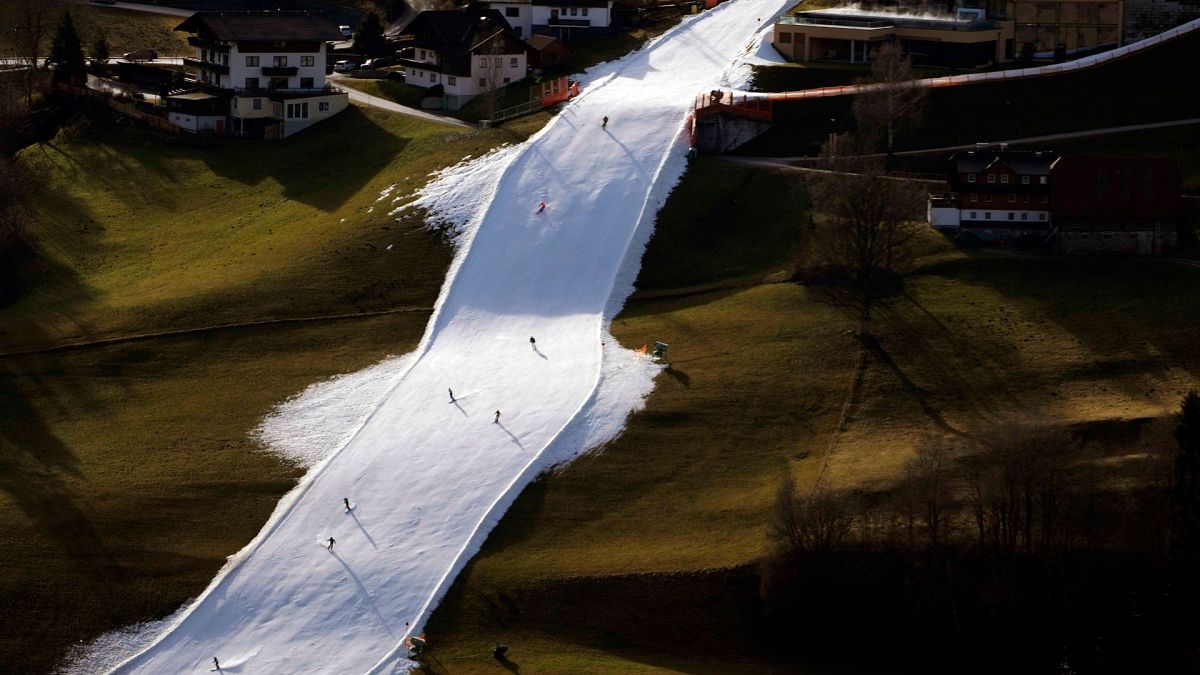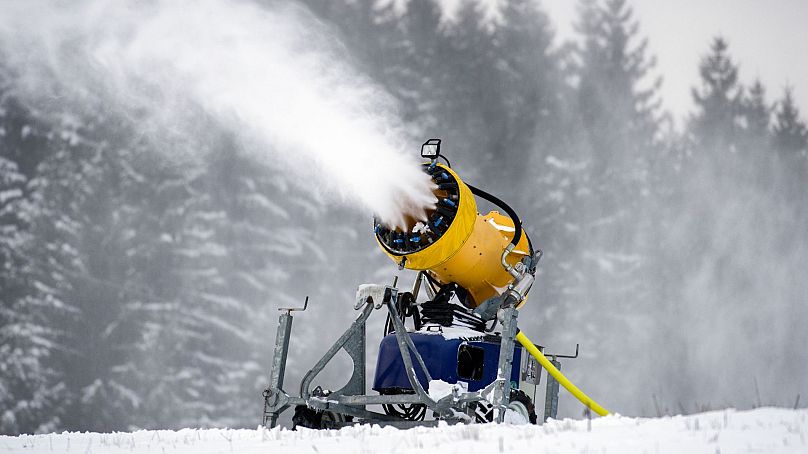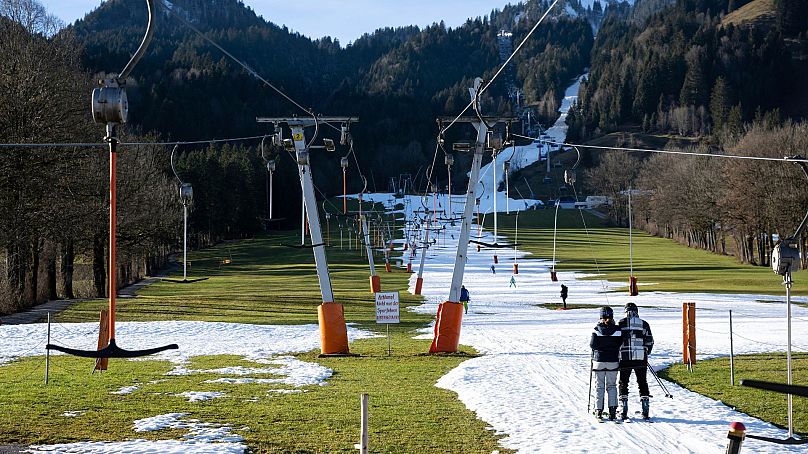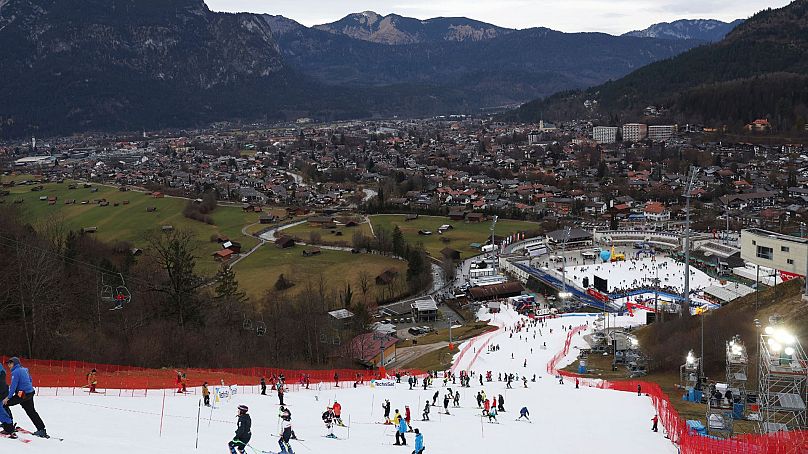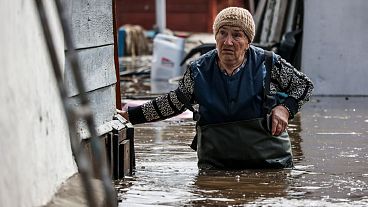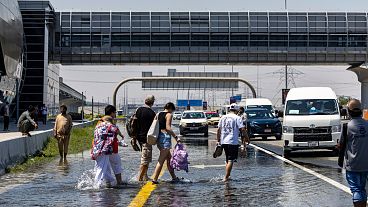Warm winters force Europe’s ski resorts to close: Is artificial snow the solution?
This year, many of Europe’s ski resorts were forced to close early as high temperatures left mountains snowless.
Some have managed to cling on with the help of artificial snow - but is this quick fix really a long-term solution?
“Snow production… only constitutes relative and transitory protection against the effects of climate change,” the Cour des Comptes (French Court of Auditors) warned in a report released in February.
As global temperatures creep towards breaching the 1.5°C warming threshold, resorts will no longer be able to rely on fake snow to survive.
How is artificial snow made?
Natural snow forms when tiny water droplets in clouds freeze and form ice crystals. These then stick together to create snowflakes. Eventually, they become heavy enough to fall to the ground.
To make artificial snow, water is cooled to just above freezing point and pumped into the air at high pressure. It is shot through small nozzles and fans of compressed air help to keep it afloat, creating a fine mist that freezes before it hits the ground.
The effectiveness of snow production tends to dwindle with rising temperatures, as it relies on cool air and low humidity. At higher temperatures, nucleating agents - tiny particles that the ice crystals can stick to - must be added to help the snow form.
What are the emissions of producing artificial snow?
Skiing is already a carbon-intensive activity, and artificial snowmaking is only a small piece of the puzzle.
In fact, ski resort operations - from ski lifts to snowmaking - only account for around 2 to 4 per cent of the total carbon footprint of a destination, according to one report.
Between 50 and 80 per cent is tied to travelling to, from and around the resort.
One of the best ways to reduce the environmental impact of your ski trip is to avoid flying to the slopes. Especially when many ski resorts around Europe can be reached by train instead.
Why is snowmaking problematic?
While its emissions may be marginal, artificial snowmaking is a money, energy and water-intensive process. This puts a strain on local resources.
Almost 1,000 litres of water are required to produce around 2.5 cubic metres of artificial snow, according to a report by the International Commission for the Protection of the Alps (CIPRA). That equates to one million litres per hectare of ski slope covered in snow.
In the French Alps, artificial snow production consumes 20 to 25 million cubic metres of water per year, equivalent to the annual water use of a city the size of Grenoble, according to the France Nature Environnement association.
The struggle for water resources is set to grow as temperatures rise, while groundwater resources are dwindling. Rainfall is lower in summer and glaciers are melting, removing a vital store of water for warmer months.
Demand for water in Europe is projected to rise between 8 and 25 per cent compared with pre-industrial levels in a 2°C warming scenario, according to a report on snow-water-energy challenges in the ski industry published in the journal Nature Climate Change.
At the same time, the electricity required for artificial snow production is expected to increase by 18 per cent as the planet warms, meaning higher costs and higher emissions.
Artificial snow is also slower to melt than the real thing, leaving the soil beneath compacted and less able to support plant growth.
Without snowmaking, however, many of Europe’s ski resorts will not survive.
“In recent times, artificial snow has become more of a necessity,” says Alex Dyer, head of customer success at tour operator Ski Vertigo. “The main driver is the less predictable and warmer weather patterns mean natural snow isn't as reliable as it used to be.”
Close to 1,200 ski resorts in 28 European countries could be at risk as global temperatures inch towards 2°C above pre-industrial levels, one recent study found.
Italy is most at risk, with 90 per cent of its slopes dependent on artificial snow, according to Italian environmental association Legambiente. Among the Alpine countries, it is followed by Austria (70 per cent), Switzerland (50 per cent), France (39 per cent) and Germany (25 per cent).
In Spain, 50 per cent of slopes are already being covered in artificial snow, France’s Agence Nationale de la cohésion des territoires (ANCT) reports.
How about snow banking?
Snow banking or snow farming is another way resorts are making up for low snowfall. When snow is plentiful it is piled up and covered with sawdust to preserve it until needed.
This can reduce the need for artificial snowmaking, but it relies on heavy, energy-intensive mechanical equipment to gather and redistribute the snow, creating noise and emissions.
It also relies on heavy snowfall at some point in the year - something that is becoming less of a guarantee - and depletes the soil beneath the snow piles.
What are the alternatives for ski communities?
Skiing is rooted in the economy and culture of many mountain communities. In the short term, artificial snow is one of their only lifelines.
“There are environmental concerns, particularly regarding water and energy use. But it's important to consider the bigger picture,” says Alex. “Artificial snow helps ski-dependent communities survive. It keeps the economy running in these areas.”
In France alone, 250,000 jobs in the lowlands and valleys depend on the ski areas opening.
As weather patterns become more difficult to predict and ski seasons are squeezed, however, some resorts are starting to diversify.
Many now offer outdoor activities beyond skiing year-round, ranging from trail running and hiking to summer sledging, mountain biking, adventure trails, watersports, horseriding, agritourism and nature or culture tours.
This, too, must be balanced with environmental concerns though.
“The development of year-round tourism offers ecological transition opportunities for mountain areas, but can also generate adverse external effects,” says ANCT. Protected natural environments could be encroached on by outdoor activities and visitor vehicles, while sites that were previously in a rest state for six months of the year could face added strain.
Efforts therefore must be made to restore and conserve ecosystems while ensuring some natural spaces are left free of human activity.
